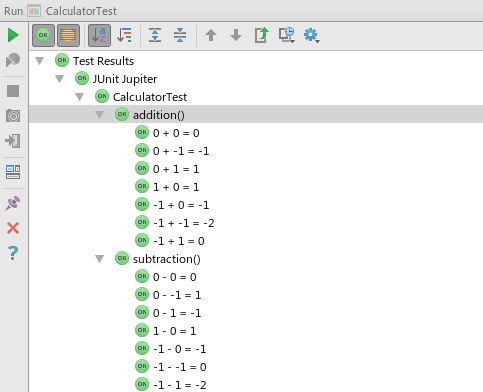Sometimes there are a lot of relevant cases to be tested for a single method. In these instances it is rather tedious to implement an unique test method for each relevant case. JUnit 5 can help you with the introduction of dynamic tests.
For starters, let's define a simple class to be tested: Calculator
This class offers two methods:
- adding two integers
- subtracting two integers
public class Calculator {
public int add(int a, int b){
return a + b;
}
public int subtract(int a, int b){
return a - b;
}
}Next we define a set of rules in two separate files: addition-rules.txt and subtraction-rules.txt
These will provide the input for our dynamic tests.
addition-rules.txt
0, 0 | 0
0, 1 | 1
1, 0 | 1
-1, 0 |-1
0,-1 |-1
-1, 1 | 0
-1,-1 |-2
subtraction-rules.txt
0, 0 | 0
0, 1 |-1
1, 0 | 1
-1, 0 |-1
0,-1 | 1
-1, 1 |-2
-1,-1 | 0
Both files use the same format: Two input variables and an expected result.
Finally we write our tests. The rule files are parsed by a separate class DataSet.
public class CalculatorTest {
Calculator cut = new Calculator();
@TestFactory
Stream<DynamicTest> addition() {
return DataSet.parseRuleFile("addition-rules.txt")
.map(dataSet -> dynamicTest(getAdditionDisplayName(dataSet), () -> {
int result = cut.add(dataSet.getValueA(), dataSet.getValueB());
assertThat(result).isEqualTo(dataSet.getExpectedResult());
}));
}
String getAdditionDisplayName(DataSet dataSet) {
return dataSet.getValueA() + " + " + dataSet.getValueB() + " = " + dataSet.getExpectedResult();
}
@TestFactory
Stream<DynamicTest> subtraction() {
return DataSet.parseRuleFile("subtraction-rules.txt")
.map(dataSet -> dynamicTest(getSubtractionDisplayName(dataSet), () -> {
int result = cut.subtract(dataSet.getValueA(), dataSet.getValueB());
assertThat(result).isEqualTo(dataSet.getExpectedResult());
}));
}
String getSubtractionDisplayName(DataSet dataSet) {
return dataSet.getValueA() + " - " + dataSet.getValueB() + " = " + dataSet.getExpectedResult();
}
}When we execute the test class within IntelliJ, we get the following result:
As you can see, JUnit generated tests using our test factories based on the input from the rule files. This example is of course rather simple. But I think it still shows what kinds of tests are possible with JUnit 5.
